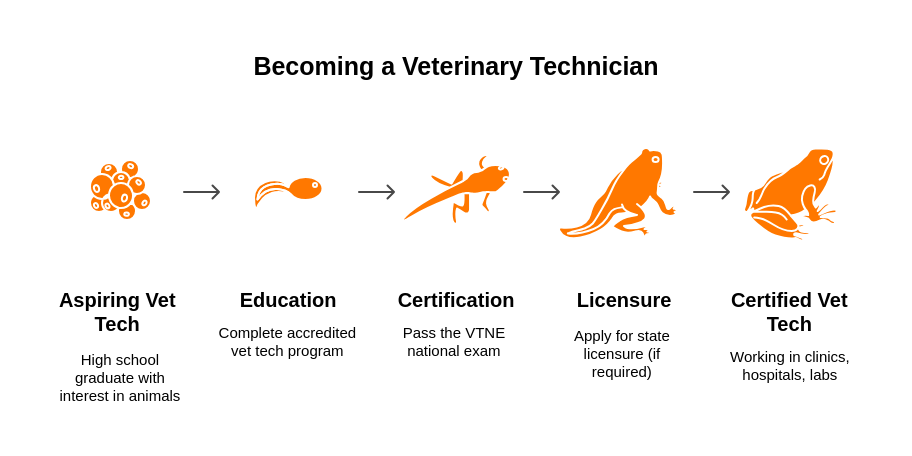How to Become a Veterinary Technician
Love animals and want a career helping them stay healthy?
Becoming a Veterinary Technician lets you work side-by-side with veterinarians in clinics, hospitals, and animal care facilities — providing hands-on medical support to pets and wildlife.
Vet techs are the healthcare professionals of the animal world. You’ll assist with exams, surgeries, lab work, and emergency care — and every day brings a chance to make a difference.
What Veterinary Technicians Actually Do
Veterinary technicians support veterinarians in all aspects of animal care and treatment.
Common Responsibilities
- Assisting veterinarians during surgeries and procedures
- Collecting blood, urine, or tissue samples for lab testing
- Administering medications, vaccines, and anesthesia
- Taking x-rays and performing diagnostic imaging
- Monitoring animal recovery and patient records
- Educating pet owners about care and treatment
Veterinary technicians are the bridge between animals, medicine, and compassion — ensuring every patient gets quality care.
How to Become a Veterinary Technician (5 Steps)
Becoming a vet tech takes dedication — but you can enter the field with a two-year associate degree and national certification.
-
Earn a High School Diploma or GED
Take courses in biology, chemistry, and math to prepare for veterinary technology programs. -
Complete an Accredited Veterinary Technology Program
Enroll in a program accredited by the AVMA (American Veterinary Medical Association).
Coursework includes:- Animal anatomy and physiology
- Veterinary pharmacology
- Surgical and clinical procedures
- Diagnostic imaging and lab testing
- Veterinary ethics and recordkeeping
Most programs take 2 years and include supervised clinical rotations.
-
Pass the VTNE (Veterinary Technician National Exam)
After graduation, you’ll need to pass the VTNE, a national certification exam administered by the AAVSB (American Association of Veterinary State Boards). -
Apply for State Licensure (if required)
Most states require a license, registration, or certification. Check your state’s veterinary board for requirements. -
Start Working as a Veterinary Technician
Vet techs are employed in clinics, animal hospitals, research labs, and even zoos and wildlife centers.
Licensing & Certification
To work as a vet tech, you’ll typically need:
- Graduation from an AVMA-accredited program
- Passing the VTNE exam
- State licensure (Registered, Licensed, or Certified Veterinary Technician)
Optional certifications are available for specialization:
- Emergency & Critical Care (VTS-ECC)
- Anesthesia & Analgesia (VTS-AA)
- Dental or Surgical Technology
Advanced certifications can lead to higher pay and more specialized roles in animal healthcare.
Skills That Make You Great at This
- Compassion and patience for animals
- Attention to detail under pressure
- Strong communication with pet owners
- Technical proficiency in lab and surgical work
- Emotional resilience and problem-solving
Great vet techs balance clinical skill with empathy — comforting both animals and their humans.
Where You’ll Work (and Grow)
Veterinary technicians can work in:
- Veterinary clinics and hospitals
- Animal shelters and humane societies
- Research laboratories
- Zoos and wildlife rehabilitation centers
- Military or government agencies
Career Growth Paths
- Veterinary Technologist (Bachelor’s degree)
- Veterinary Practice Manager
- Specialty Technician (Emergency, Surgery, Dentistry)
- Animal Nutrition or Research Specialist
Pros & Cons
Pros:
- Rapidly growing career field
- Deep emotional satisfaction helping animals
- Variety of work environments and specializations
- Entry-level career with advancement opportunities
Cons:
- Physically and emotionally demanding
- Exposure to injured or sick animals
- Moderate pay compared to human healthcare fields
Start Your Veterinary Technician Journey
If you’re passionate about animals and want a career that blends science, care, and compassion, veterinary technology is the perfect fit.
Turn your love for animals into a lifelong career in veterinary medicine.

Veterinary Technician Salary by State

Meet the author: Brad Fishbein is a Florida Licensed Mold Assessor and council-certified Microbial Investigator. He’s the founder of TradeCareerPath.com and has completed over 5,000 mold inspections since 2009. Brad now helps homeowners and tradespeople make smart decisions about mold, licensing, and skilled career paths.
Notice an update we should make?
We strive for accuracy. Contact us here if you see incorrect or outdated info on this page.